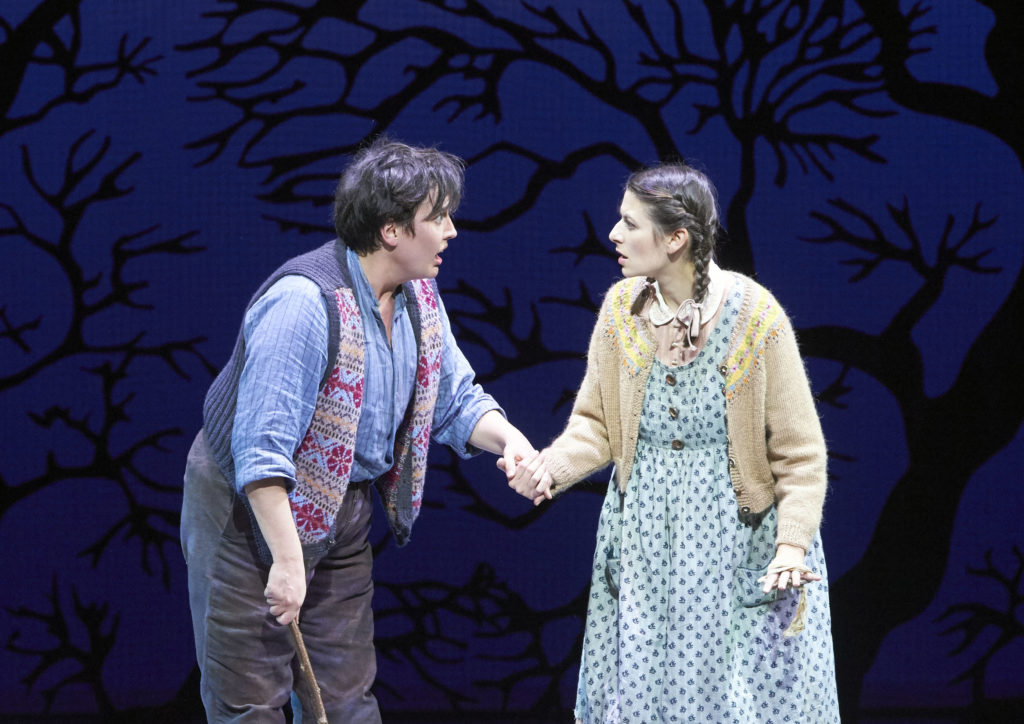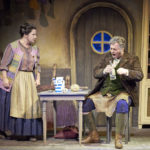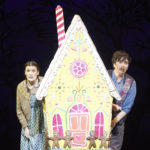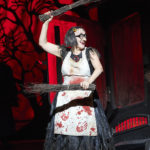 Hänsel und Gretel is no mere children’s opera. Richard Strauss, who gave its premier in 1893 Weimar, regarded Humperdinck’s opera as a masterpiece, as did Gustav Mahler. Humperdinck as devotee and assistant to Wagner composed a post-Wagner opera, at once listenable and complex, multi-layered and poetic: appealing equally to children and adults through its familiar plot and hit tunes. Hansel and Gretel are sung by adults, as if prefiguring 20th century child psychology: the notion that adults never quite grow up, our childhood fantasies locked away in the subconscious.
Hänsel und Gretel is no mere children’s opera. Richard Strauss, who gave its premier in 1893 Weimar, regarded Humperdinck’s opera as a masterpiece, as did Gustav Mahler. Humperdinck as devotee and assistant to Wagner composed a post-Wagner opera, at once listenable and complex, multi-layered and poetic: appealing equally to children and adults through its familiar plot and hit tunes. Hansel and Gretel are sung by adults, as if prefiguring 20th century child psychology: the notion that adults never quite grow up, our childhood fantasies locked away in the subconscious.
Adrian Noble, once Royal Shakespeare Company director, and behind a string of legendary West End musicals; now opera producer he directs Vienna State Opera’s fantasy-rich Hänsel und Gretel, using Anthony Ward’s imaginative sets. The stage curtain is a gigantic eye, the size of the whole stage- comprising clouds in motion (video Andre Goulding), its blood-vessels resembling trees. It lifts on a traditional late-Victorian living room, with Wedgwood cameos on the walls, and a Christmas tree in the corner. A family are watching black-and-white slides, a ‘magic lantern’, showing a fantasy world. This is the backdrop to the overture, sumptuously played by Vienna State Opera Orchestra passionately conducted by Axel Kober. The set moves away to show the adult-size Hänsel and Gretel in white walking into the forest.
 A chalet, with father, Peter, (Sebastian Holocek) at his workbench, ‘the cobbler has leather, but no last.’ Gertrud (venerable soprano Donna Ellen) sits knitting. Nothing but dry bread! As Gretel, Chen Reiss’ soprano has a gloriously affecting clarity. How long since we had a square meal. Hänsel is rather big-built, Margaret Plummer in a ‘trouser role’ , but these are short trousers. Written for a ‘highly lyric mezzo, or full-bodied lyric soprano’, according to the programme, with vocal power needed to make this ‘spirited boy credible.’ But for me these voices are not sufficiently differentiated- although Reiss fits ‘the high, clear, bright, girlish lyric soprano par excellence’ called for – the very qualities Reiss drew on playing Janacek’s Cunning Little Vixen (in 2015).
A chalet, with father, Peter, (Sebastian Holocek) at his workbench, ‘the cobbler has leather, but no last.’ Gertrud (venerable soprano Donna Ellen) sits knitting. Nothing but dry bread! As Gretel, Chen Reiss’ soprano has a gloriously affecting clarity. How long since we had a square meal. Hänsel is rather big-built, Margaret Plummer in a ‘trouser role’ , but these are short trousers. Written for a ‘highly lyric mezzo, or full-bodied lyric soprano’, according to the programme, with vocal power needed to make this ‘spirited boy credible.’ But for me these voices are not sufficiently differentiated- although Reiss fits ‘the high, clear, bright, girlish lyric soprano par excellence’ called for – the very qualities Reiss drew on playing Janacek’s Cunning Little Vixen (in 2015).
The mother Gertrude arrives furious, and gives him a good slap: to see them dancing around as if in a village fete! She hasn’t knitted stockings; he hasn’t bound any brooms. She sends them out into the forest to pick strawberries. And if the basket isn’t filled…
Donna Ellen’s Gertrude’s lament about their miserable life is genuinely moving. O, God please send us some money. Not a drop of milk- she’d knocked the jug over in her temper- only water, she complains.
Tra la la: I’m home bringing good fortune, Gertrude. Everything tastes good when you’re hungry. Jovial, white-bearded, Holocek has a fabulous bass-baritone. The role of Peter Besenbinder could have inspired Anatevka‘s Fiddler on the Roof (although Polish shtetls are far-removed from this proto-Wagnerian world.) Yes, hunger is a tremendous thing. It’s been a wonderful day, hasn’t it; he’s sold all his brooms and bought food. Now, what’s for supper? She’s got nothing.
But where are the kinder? Their joy is dampened. He sings to her about the Ilsenstein witch in the depths of the forest, who gets her magic from the devil himself. She tempts children into her cottage with her magic cookies- then into the oven, out come gingerbread children. (Sounds like an advert for lebkuchen.) But this is all deadly serious, and they rush out to find their children before nightfall. Grimm’s Fairy Tales , on which the story is based, were known for their grisly social realism in an age, the 19th century, when young children were exploited as slave labour in factories and sold into prostitution.
We see the children’s silhouettes as if through a gigantic telescope in that magnified eye. They’re gaping in wonderment. Ein Männlein steht im Walde ganz still und stumm . They sing the opera’s signature tune (a traditional children’s song.) Her basket is full; mother will be pleased. Hey, do you see the wood…Kuckuck, eigentlich (an actual cuckoo). It’s all quite charming, evoking childlike innocence. She makes a wreath; they play games, eat all the strawberries lose track of time and their way. ‘Gretel ich kenn den Weg nicht mehr!’
The sandman, like a good angel (Maria Nazarova) , a platinum blonde figure in a trailing sky-blue gown patterned with cloud motifs, beckons them to sleep, Abends wenn ich schlaffen gehen. . Wonderful stage effects. A man-in-the moon amongst floating clouds; indicating heavenly paradise, moonbeams shower the stage; then, in a dreamscape, a balloon tree, and angelic girls in white dresses march in holding up white balloons.
 There’s a doll’s house centre stage. Did you hear it, the heavenly wind? Did you smell that- the gingerbread cookies to entice them . The witch! In a crinkled shiny black dress , a white pinafore daubed in red hand imprints, wearing gook black spectacles. Michaela Schuster creeps up behind Plummer’s Hänsel, lassoes him with her thick rope and tightens the grip. Right of stage we see a surrealistic oven , the grille as if smiling, thin-lipped. And a huge cage suspended, with perched above, a giant bird of prey, its beak extended. Behind, in the shadows ghostly mannequins of children. She sings, promising great joy: she loves children (and intends to fatten Hänsel up.) Hänsel tries to escape; she casts her spell, he freezes and in a trance enters the cage. Humperdinck’s music is playful, ironic , with macabre hints. Schuster, her dark-toned mezzo self-ironic, sings gleefully, the little girl’s asleep; how the young sleep. Gretel, she’ll be tender and plump.
There’s a doll’s house centre stage. Did you hear it, the heavenly wind? Did you smell that- the gingerbread cookies to entice them . The witch! In a crinkled shiny black dress , a white pinafore daubed in red hand imprints, wearing gook black spectacles. Michaela Schuster creeps up behind Plummer’s Hänsel, lassoes him with her thick rope and tightens the grip. Right of stage we see a surrealistic oven , the grille as if smiling, thin-lipped. And a huge cage suspended, with perched above, a giant bird of prey, its beak extended. Behind, in the shadows ghostly mannequins of children. She sings, promising great joy: she loves children (and intends to fatten Hänsel up.) Hänsel tries to escape; she casts her spell, he freezes and in a trance enters the cage. Humperdinck’s music is playful, ironic , with macabre hints. Schuster, her dark-toned mezzo self-ironic, sings gleefully, the little girl’s asleep; how the young sleep. Gretel, she’ll be tender and plump. 
The witch story should be so scary as to send shivers up your spine- young or old (writes Oliver Lang in Prolog.) Schuster, tremendously powerful in Wagner, here creeps around like some camp fairy. Not really frightening: but our shock threshold has changed since the relatively tranquil late-19th century. Schuster does a tango with her broomstick, waving the broomstick around, swinging it like a baton. Behind, lightning forks and the clouds whirl at high speed. But this witch is hardly more credible than a panto dame! But, of course, you don’t get Michaela Shuster at the Brighton Pavilion.
Her plans to push Gretel into the oven backfires. Poor Gretel; the heat of the oven which scalds her hand looks real enough, but Reiss, acting dumb, gets the witch to show her around the oven. They push Schuster in : now she’ll be the roast. The spell broken, the children cast into lebkuchen emerge liberated; just look at all those children! Centre stage , there’s a gingerbread dame, they dance around, Hänsel and Gretel reunited with their parents. They sing, Wenn die Not aufs Höchste steigt, Gott der Herr sich gnädig zu uns neigt.. When the going gets tough …
This is the classiest pantomime you will ever see. But much more. Humperdinck’s score -originally composed as a short fairy tale piece of four songs- is an operatic masterpiece: a musical delight, its tunes ringing in your ears. Noble’s post-modern update, ingeniously based late 19th century, isn’t perfect, but infinitely preferable to those moribund, antiquated forest settings.© PR. 2.1.2017
Photos: Margaret Plummer (Hänsel) and Chen Reiss (Gretel); Donna Ellen (Gertrude)and Sebastian Holocek (Peter Besenbinder); Michaela Schuster (the witch); featured image Margaret Plummer and Chen Reiss
© Wiener Staatsoper/ Michael Pöhn
viennaoperareview.com
Vienna's English opera blog

Awesome article.